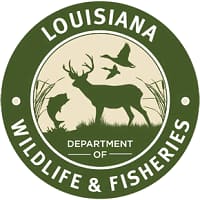Louisiana DWF Reminds Waterfowl Hunters to Be Alert for Whooping Cranes

As young waterfowl hunters prepare for the Nov. 2-3 Youth Waterfowl Weekend in the state’s coastal zone, the Louisiana Department of Wildlife and Fisheries (LDWF) is reminding all waterfowl hunters to be alert for whooping cranes in marshes and fields that contain legally hunted game birds.
LDWF’s whooping crane reintroduction program has released cranes into the wild from White Lake Wetlands Conservation Area each year since 2011. The birds have dispersed over time to locations that include east Texas, but there are whooping cranes situated in Acadia, Avoyelles, Calcasieu, Cameron, Jefferson Davis, Rapides and Vermilion parishes.
Anyone encountering whooping cranes in the wild is advised to observe them from a distance and minimize any disturbance. Hunters are cautioned to positively identify their targets as game birds before shooting. Although whooping cranes in Louisiana are considered an “experimental, non-essential population” under the Endangered Species Act, they are still protected by the Migratory Bird Treaty Act and cannot be pursued, harassed, captured or killed.
Waterfowl hunters should be accustomed to seeing large-bodied, white birds with black wing-tips, such as white ibis, white pelicans, and wood storks, which must be distinguished from the legally-hunted snow geese. Whooping cranes are equally identifiable as they stand an impressive 5 feet tall and have a wingspan of 7-8 feet. Easily identifiable characteristics of whooping cranes in flight include fully extended neck and legs, and black wing tips. Photos of the cranes and similar species can be seen on the LDWF website at http://www.wlf.louisiana.gov/document/whooping-crane-identification-fact-sheet or in the 2013-14 Louisiana Hunting Regulations pamphlet between pages 30 and 31.
Hunters are encouraged to report whooping crane sightings to assist the department in tracking their movements. Location information can be reported to the White Lake WCA office at 337-536-9400, ext. 4 or szimorski@wlf.la.gov .
LDWF also asks experienced hunters to take the time in the field to educate young hunters and improve their target identification skills to distinguish game birds from non-game birds. A whooping crane sighting can add to the outdoor experience for outdoorsmen and women of all ages and hunter vigilance can assist the department’s efforts to restore this unique species in southwestern Louisiana.
Anyone witnessing whooping cranes being pursued, harassed, captured or killed is urged to call the LDWF Enforcement Division’s Game Thief hotline at 1-800-442-2511 to report what they’ve seen.
For more information, contact Bo Boehringer at 225-765-5115 or bboehringer@wlf.la.gov .

